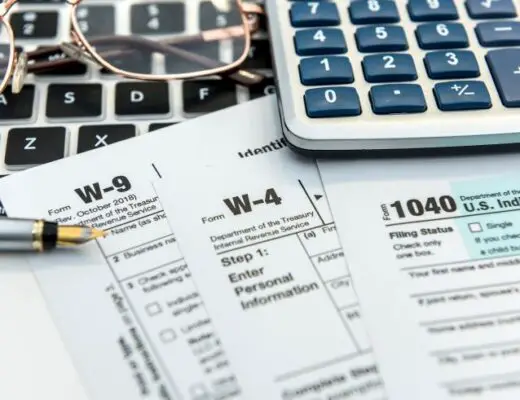
CommonCentsMom.com is advertiser-supported: we may earn compensation from the products and offers mentioned in this article. However, any expressed opinions are our own and aren't influenced by compensation. The contents of the CommonCentsMom.com website, such as text, graphics, images, and other material contained on this site (“Content”) are for informational purposes only. The Content is not intended to be a substitute for professional financial or legal advice. Always seek the advice of your Financial Advisor, CPA and Lawyer with any questions you may have regarding your situation. Never disregard professional advice or delay in seeking it because of something you have read on this website!
Quick Answer
A 50cc moped can be purchased for much cheaper than a car, and costs significantly less to maintain and use. I found several listings under $1,000 just by doing a simple Google search. Only a few were priced above $1,000, so it’s fairly safe to say that buying a moped outright will be significantly cheaper than buying a car.
If you live in the US, you might remember the consistent and somewhat steep rise in gas prices we saw immediately following the housing crisis of 2008. Using data from Trending Economics, we see that average gas price was $2.27 in 2008. By 2015, it had reached about $3.79!
When that happened, everyone was looking for cheaper ways to get around. After peaking in 2015, though, gas prices started to fall. They haven’t reached that level since, but that doesn’t mean you can’t still save on transportation!
One potential option is a moped. These bikes are much smaller than cars and are thus much cheaper. They also use quite a bit less fuel. But is that really all there is to it?
Mopeds vs. Scooters
When it comes to motorcycles, there are a few different types that you may be interested in. The first type is a dirt bike. Dirt bikes are typically much smaller than motorcycles, and they’re designed for off-road use. They usually have smaller engines and lower top speeds, which makes them great for riding around town.
The second type of motorcycle is a regular motorcycle. Motorcycles are larger than dirt bikes, and they typically have bigger engines and higher top speeds. They’re perfect for long rides on the open road.
The final type of motorcycle is a dual-sport motorcycle. Dual-sport motorcycles are designed for both off-road use and street use. They have big engines that can handle both off-road terrain and street conditions.
I’d like to briefly clarify the difference here, because many people (myself included) may not have realized there is a difference. Luckily the difference is fairly simple, so the explanation is brief.
Simply put, the vehicles are very similar. The biggest difference is in the engine size. The engine in a moped can go up to 50cc. That engine gets you a top speed of 28 MPH – relatively low, but enough to get around town.
Scooters, on the other hand, have much larger engines. The engines can go high for these 150cc scooters. Research seems to vary a bit in terms of what that means for top speed, but it seems to be anywhere from 50-100 MPH. Because motor scooters have much larger engines with higher top speeds, they also cost more. So, if your primary goal is to save money, a moped scooter is your best bet.
Mopeds and scooters both use pedals to propel the vehicle. Mopeds use a single pedal, while scooters use a pair of pedals. Mopeds also have a smaller gearbox than scooters, which means they can’t go as fast. While pedals are the same on both vehicles, the gearbox on a moped is much simpler than a scooter’s. This means that repairs and maintenance are typically easier on a moped.
If you’re looking for a vehicle that can get you around town quickly and cheaply, a moped may be the right choice for you. On the other hand, if you’re looking for something with a bit more oomph, a scooter may be better suited. It all comes down to what your priorities are.
In addition, ATVs and dirt bikes are not typically considered mopeds or scooters. They are their own category, and they use different engines and gearboxes. So, if you’re looking for a vehicle that falls into one of these categories, be sure to check the specifications carefully.
Are Mopeds That Much Cheaper?
Yes, you are probably wondering whether mopeds are that much cheaper. After all, wouldn’t everyone be using them if they were? For some reason, research on the cost to own a moped is much slimmer than that of owning a scooter. I can only infer the reason; my best guess would be the limitations of a vehicle that tops out at 28 MPH, as mentioned above.
How much is a moped? A 50cc moped can be purchased pretty cheaply. I found several listings under $1,000 just by doing a simple Google search. Only a few were priced above $1,000, so it’s fairly safe to say that buying a moped outright will be significantly cheaper than buying a car.
Moped Life Expectancy
To find anything resembling a definitive answer to this question, I had to delve into some forums to find answers from real people. Millions of people drive cars in the US, and so there is extensive data on things like how long they last. When it comes to mopeds, though, there isn’t quite the wealth of information out there.
Even when trying to find my answer, I did notice a lot of people using “moped” and “scooter” interchangeably, despite the clear difference I noted earlier. Thus, this thread seemed to give the best answer. Although even then, the original poster called it a “50cc scooter.”
Nevertheless, some commenters cited relatively low mileage numbers; one mentioned he would expect maintenance to be necessary after about 10,000 miles. On the other hand, one mentioned his having over 20,000 miles and yet it “runs sweet.”
Moped vs. Car
While it is difficult to ascertain precise numbers, based on the forum linked above I am going to use ballpark figures and say that a $750 moped will last about 20,000 miles before needing repairs. Similarly, I would expect a $20,000 car to start needing repairs around the 100,000-mile mark.
Again, these are approximate figures, and your mileage may vary (literally), but if these numbers are anywhere close to accurate, it’s easy to see a moped would be a lot cheaper. Even if we multiply the $750 by five, since that is how many more miles I’m using for the car, we get $3,750. Still a whole lot cheaper than the car.
Not only that, but a 50cc moped will get about 100 MPG. Again, that offers significant savings over the typical gas mileage of a car. Additionally, at least some states don’t require insurance. Some states do, but it is still going to be less than car insurance.
So, indeed, it does appear that mopeds are cheaper than cars.
Cost vs. Convenience
One last point here is the obvious one of convenience. Although mopeds are almost certainly cheaper to use than cars, let’s not forget that cars have several advantages of their own.
Cargo is one of them. I did find several moped drivers online who mentioned they mount packs to their mopeds that allow them to carry quite a bit. Some said those packs are sufficient to carry their weekly groceries comfortably. Still, one cannot deny the fact that a car can haul more.
There are other considerations, too, such as riding in the rain. In yet another show of rebuttal, I found moped riders who mentioned they have things like rain pants and other rain gear that makes riding in the rain easier. But, again, it’s hard to imagine this beats being a cabin that always stays dry.
Base Purchase
Of course, this discussion of the financial cost of moped ownership must begin with a breakdown of the base purchasing cost. That is to say, you should be sure that you have enough money to buy a moped and drive it off the lot before selling your car.
Mopeds are nearly always cheaper than cars in this category, even when compared to used vehicles. This is especially the case when you consider that most mopeds are purchased all at once, as opposed to the installment plan system to pay down the high up front cost of a car. This alone can save you a great deal of money as time goes on due to the lack of interest on a car payment or loan.
As far as price specifics go, you’ll need to complete your own research on this front simply because moped and prices can vary so greatly from brand to brand (not to mentions devaluations related to new or used statuses). However, while you compare base prices, be sure to take into consideration special deals offered by your local dealers. These discounts can really lower your barrier to owning a moped.
Fuel
Fuel is a positively crucial cost consideration that you must factor in while evaluating whether you should switch to a moped for its financial savings. As you might expect, mopeds feature far smaller fuel tanks and thus, cost less to fill up per instance. But while you should, of course, compare raw fuel fill up prices, you should also take time to factor in fuel efficiency as a matter of financial resource usage.
Fuel efficiency, as a metric in miles per gallon (mpg), describes how much fuel a motorized engine uses while in regular operation. Many modern cars feature fuel efficiencies around 25-30 mpg, while some mopeds can top out around 140 mpg. That’s a night and day difference that certainly points to a moped as a cheaper option when it comes to fuel costs (even with a smaller gas tank).
Here again, you’ll need to take comparisons found online with a grain of salt due to regional differences in gas prices. However, you may be able to forgo such fuel efficiency and gas tank comparisons if you are looking at electric-powered mopeds. Without a doubt, an electric moped would be cheaper to operate given their usage of cents worth of electricity per recharge.
Licensing
While you may have found an affordable moped that you believe will be cheaper to operate compared to your car, you shouldn’t commit to purchasing it until you’ve also factored in the cost of licensing that vehicle. Just like your car, this will mean going down to the DMV and registering for a set of license plates so that your moped can legally operate on public roads.
This cost will vary from state to state. Some states such as Michigan require a flat $15 rate for a three-year moped license registration. Other states, like Illinois, charge around $38 for a standard motorcycle license. Often, your moped licensing cost will come out to slightly higher than this flat rate, however, due to the need to also add a title your new scooter mode.
Also, your local jurisdiction may require additional licensing in order to legally operate or park the motor bike within its confines. Such is often the case in urban centers where compact mopeds have gained great popularity. Chicago is a prime example of this kind of added licensing cost, given that they require an annual $45 sticker for all mopeds that park within city limits.
While evaluating licensing costs, don’t forget to add yourself into the equation. Depending on your state law, you may need to gain a new driver’s license certification to legally operate your moped. Often, your need for additional licensing will depend on your moped’s mechanical capabilities. In Illinois, for example, you would need to acquire a Class L license (for motorcycles) if your moped can drive at over 30 mph or can displace at a higher than 50cc gas rate.
Insurance
Next up, you’ll need to factor in the cost of insurance for your moped and compare it to your current car insurance rate. As a matter of raw pricing, moped insurance costs will almost certainly be cheaper simply because there are fewer physical assets to insure against damage. Actual pricing will vary from person to person, though, especially when factoring in risk factors such as collision probability and individual experience operating a moped.
Of course, purchasing insurance for your moped is a matter of good practice that will certainly make them cheaper to operate in the long run, especially if an accident were to occur. However, carrying moped insurance is not necessarily required in all jurisdictions. In Illinois, moped insurance is required (as is vehicular insurance) while its immediate neighbor Indiana does not require this kind of protection policy from moped operators.
Miscellaneous Resources
While operational price is often at the top of most prospective moped user’s list, cost shouldn’t be the only factor that goes into comparing a moped to a car. Indeed, there are non-financial benefits and drawbacks that an informed consumer must factor in before committing to a change in their primary mode of transportation.
The “cost” associated with these following factors are qualitative in nature. As such, their ultimate impact should be aligned with your needs as a commuter, rather than the demands of your budget. Don’t ignore these miscellaneous resource considerations or you may find yourself owning a moped that leaves you without the freedom of movement you desire:
Capacity
Even if you have found that your moped of choice will be operationally cheaper than your current car, you still shouldn’t make the switch until you’ve fully appraised how much carrying capacity you will lose as a result of the switch. Even a compact car tends to include a passenger seat and trunk for storing your belongings while you travel; at best, a moped may include some side compartment and room for one passenger to ride along.
If you primarily use your vehicle to commute to work with a small volume of belongings, this loss of carrying capacity may not be a big issue for you. But with this switch, you’ll lose the convenience of carrying more than one friend around with you for recreation. Also, you’ll lose the ability to move about larger-than-average loads of goods such as groceries or personal belongings when moving to a new home or apartment.
Should you try to carry a descent volume of materials on your new moped, you may find operating the vehicle to be more difficult (if not outright dangerous). Also, because they are an open-air mode of transportation, all belongs (and people) on the moped will be continuously be exposed to the elements, including rain in the spring and snow in the winter. Suffice to say, this loss of capacity and protection can really put a damper on owning a moped.
Long-Distance Travel
As noted, mopeds are exceptionally fuel efficient, with ratings often exceeding 100 mpg. While these compact modes of transportation are often able to travel great distances, they are by no means the most efficient or comfortable method of doing so. Most mopeds only travel at a 30 mph top speed, making them a slow method of reaching far off destinations. In many states, you won’t even be able to use the interstate if you can’t travel above the minimum speed limit.
Even If you choose to ride your moped for the long haul, there’s no promise of comfort while you travel. Modern cars include built-in air conditioning, which can make the difference when it comes to surviving the boiling summer sun; mopeds lack these capabilities entirely. Though the breeze from open-air movement provides some relief, you may not get to fully enjoy it if you are wearing a proper motor bike-class helmet (which is heavily advised, regardless of local laws).
Ultimately, mopeds are built only for short distance commuting and should only be relied upon for that range of travel. If you have access to a full-sized car (either through a spouse, partner, or friend), you may be able to mitigate this limitation. But even so, your ability to travel long distances on your own will dry up if you fully commit to operating a moped full time.
Emissions
Not all of these factors relating to miscellaneous resources are demerits against moped ownership, though. In fact, mopeds have a major bright spot when it comes to cutting down on harmful environmental emissions when compared to a standard car. While the difference is challenging to quantify in raw numbers, most mopeds produce fewer harmful emissions from their gasoline combustion engines by several orders of magnitude.
While this minimization of emissions is impressive on its own, this factor can be even further enhanced by investing in an electric moped. These models cut harmful emissions to near negligible levels, allowing you to commute regularly without contributing to environmental emission (at least when it comes to your mode of transportation).
Overall, this decreased rate of emissions is a major reason why eco-friendly commuters are beginning to rely on compact motorized vehicles such as mopeds. When it comes to the “cost” of protecting air quality and the environment, mopeds certainly incur the smaller bill when compared to cars.
Moped Brands
Vespa is one of the most well-known brands of mopeds. Other brands include Honda, Yamaha, and Kawasaki. Dealership locations for these brands vary, so it’s important to do your research before making a purchase.
Automatic transmission is available on many mopeds, but not all. If you’re looking for a moped that has an automatic transmission, you’ll want to make sure the model you choose has one.
Moped Maintenance
Moped maintenance is pretty simple. All you need to do is check the oil and brake fluid levels, and make sure the tires are properly inflated. Mopeds also tend to have small engines, so they don’t require a lot of maintenance. Disc brakes are also a common feature on mopeds, so make sure to keep an eye on the pads and rotors.
Moped Safety
Just like with any other vehicle, moped safety is important. Make sure to wear a helmet when riding, and always ride defensively. Don’t assume that just because a moped is small, it can’t handle the road well. Always take the time to learn about the moped you’re considering buying, and make sure to ask your dealership any questions you have.
Wrapping it Up
In conclusion, I would say that mopeds are clearly cheaper to run than cars. They cost less, are better on gas, and in some states do not even require insurance (though this varies).
Just remember that even though they are cheaper, you are very possibly sacrificing some niceties offered by cars. Top speed is low at under 30 MPH. Driving in the elements could prove to be a pain, as could hauling a large amount of cargo.
In the end, it really depends on your individual needs. Do you want to have the wind whipping against your face at a brisk 28 MPH? If so, a moped could be the right call. But if you regularly have a lot to haul or live in harsh conditions, a car may still be the best choice.
Broadly speaking, owning and operating a moped is nearly always cheaper than owning and operating a standard car. Even compared to used cars, mopeds are often far cheaper when it comes to base costs because they don’t require interest-inflated installments to pay for. With far higher fuel efficiency and lower insurance costs, you’ll also save money month after month as you travel to and from work.
That being said, mopeds aren’t the perfect mode of transportation by any means. If you elect to ride a moped full time, you’ll sacrifice much of the convenience of a car when it comes to traveling long-distance or carrying a large volume of materials from place to place without exposure to the elements.
But if you’re focused on price alone, a moped may well be a financially savvy move to fit your budget. Be sure to evaluate your current and future transportation needs in advance and you’ll surely be able to select the most prudent option to fit your transformational lifestyle.






